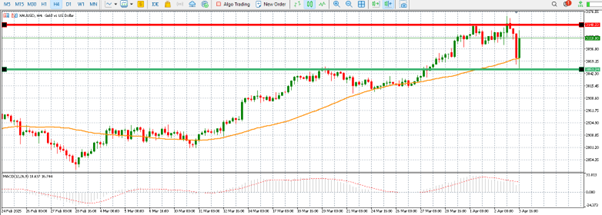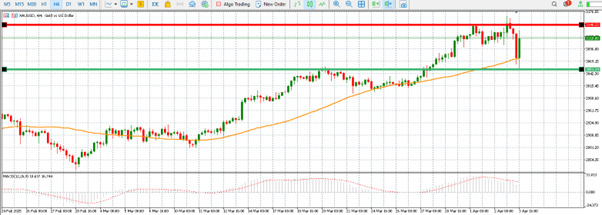In a shocking move last night, former President Donald Trump announced a new round of taxes on goods from around the world. This caused gold prices to skyrocket as investors rushed to buy safe assets. The news caused more instability in the financial markets, which were already tense because of worries about inflation and the economy. This sent gold to new highs overnight.
Trade Wars Under Trump and People Running for safety
Trump's new trade policy puts a 10% tax on all goods that come from other countries. Some countries, like China, the EU, Japan, and Brazil, will also have to pay extra tariffs in return. This bold attitude instantly made people in the U.S. worry about a new global trade war, problems in the supply chain, and higher costs for both producers and customers.
Gold prices went through the roof as usual when there was a lot of political unrest or problems in the economy as a whole. People bought precious metals to protect themselves from instability, inflation, and falling currencies. The price of precious metals went through the roof as the market thought about what higher nationalism and possible reaction from global trade partners could mean.
The Dollar Index and the Rise in Gold
The U.S. Dollar Index (DXY) had a mixed day while gold prices went up. One the one hand, the dollar usually gets stronger when people around the world are afraid of taking risks because it is seen as a safe haven. But these taxes may have long-term effects that could make the dollar weaker, especially if the economy slows down or prices go up. This could change the Federal Reserve's current path.
Gold moved a lot because of this tug-of-war between short-term dollar growth and long-term economic instability. What's the end result? As capital seeks shelter from the expected economic effects of a more conservative U.S. trade stance, this is a clear sign that gold will rise in the short run.
Jobless claims show that the job market is strong.
The U.S. weekly jobless claims report that came out today was better than expected, which added to the market's mood. The number of Americans applying for jobless benefits dropped by 6,000, to 219,000. This supports the idea that the job market is still strong, despite the noise in the larger economy.
Based on these numbers, it looks like the U.S. economy is still doing pretty well, at least for now. But the main question that still needs to be answered is whether the job market can remain strong in the face of rising trade tensions, possible inflation, and increased buyer pressure.
When it came to gold buyers, the jobless claims data gave the rise a short break. The dollar and risky investments tend to do better when the job market is good. This can make gold prices go down. However, the bigger picture still supports gold because of the changes from outside caused by Trump's policy change.
The Non-Farm Payrolls Report comes out tomorrow.
The market will now pay close attention to the U.S. Non-Farm Payrolls (NFP) statistics that comes out on Friday. After a reading of 151,000 jobs added last month, most economists think that 140,000 jobs will be added this month. The rate of unemployment is likely to stay the same at 4.1%.
This study could change the course of gold's price. If NFP comes in higher than expected, it could boost trust in the U.S. economy, make the dollar stronger, and hurt gold. On the other hand, a bad number would probably make the positive trend for gold stronger, especially if buyers see it as an early sign of economic slowdown caused by trade.
What Traders Need to Know
The rise in gold prices is both a chance and a risk for short-term buyers. In the short run, volatility is likely to stay high, and key support levels have already been tried. If the NFP numbers are bad, gold prices could go through the roof, especially if the dollar falls in reaction.

Gold Trading chart by Exness
Long-term and medium-term buyers may see this as proof of gold's larger trend: an asset that does well when things are unclear, the economy is bad, and the central bank is only reacting.
In conclusion
Trump's tariffs have made people around the world afraid of trade again, so gold is once again seen as a safe investment. The jobless claims numbers from today gave us a small moment of hope for the U.S. economy, but now all eyes are on tomorrow's NFP report. The next part of gold's price movement will depend on how the market handles these different political, economic, and monetary factors.
Gold is still the most talked about thing. And since there is more unpredictability in the world, it might not be done going up yet.
